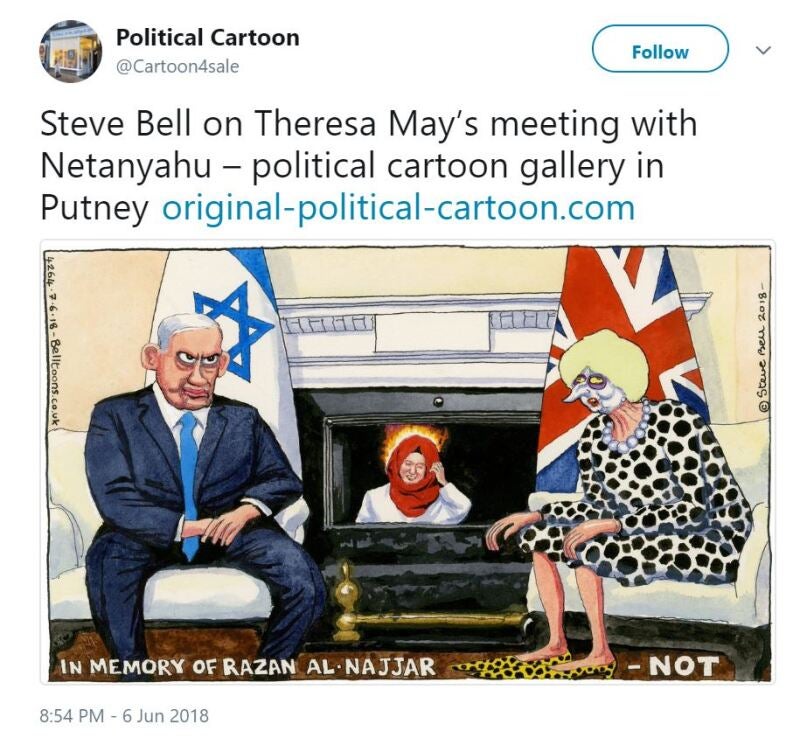
A cartoon by the Guardian’s Steve Bell which was spiked because it “conjured up an image of the Holocaust” has been described as a “clanger” and “insensitively and counter productively ill-judged”.
The verdict from Guardian readers’ editor Paul Chadwick comes two weeks after the cartoon was leaked online amid a public row between Bell and the newspaper in which he claimed he had been “censored”.
Bell also said Guardian editor Kath Viner had set an “unfortunate precedent” by not publishing the image.
The cartoon, a reaction to the death of 21-year-old volunteer medic Razan al-Najjar at a Gaza fence protest, depicted Israeli prime minister Benjamin Netanyahu with Theresa May on 6 June, the day of their meeting at 10 Downing Street.
Between the leaders was a fireplace containing an image of Najjar, her red scarf in flames around her head.
Guardian editor Katharine Viner (pictured) spiked the cartoon after the opinion page team were united in thinking it was offensive, Chadwick’s probe into the matter revealed.
Viner told Chadwick it “seemed clear” the cartoon conjured up an image of the Holocaust, and that Bell’s point – that Najjar’s death hung over the meeting between Netanyahu and May – “could easily have been made in a way that didn’t reference fire or ovens”.
Viner stood by her decision, saying: “As editors we edit all the time. That’s our job”.
The incident angered Bell, who protested in two emails copied to the entire editorial staff of the Guardian, one of which contained the cartoon, that were leaked to Huffpost UK.
Bell has told Chadwick it was not his “express or conscious intention” to leak the cartoon to the wider world with his emails.
He initially asked his fellow journalists to be “as frank as you like” about the cartoon, writing: “I wouldn’t normally do this, but I think that this cartoon, which has just been spiked, has been unfairly traduced and censored.
“I think it’s a shame because, so far, I can only find one mention of her [Najjar] on the entire website, and this would at least have been the second.”

The next morning, he wrote directly addressing Viner, saying he believed an “unfortunate precedent” had been set and that he could not “for the life of me” understand criticism of the cartoon relating to the Holocaust.
“That was the last thing on my mind when I drew it,” he said, adding: “The cartoon is sensitive, not tasteless, not disrespectful, and certainly contains no anti-Semitic tropes.”
Bell resubmitted an edited version of the cartoon but Viner told Chadwick that once the original had been leaked and published elsewhere online, “an amended cartoon was then out of the question”.
Bell told Chadwick he was concerned about “a kind of growing visual prudishness”.
He added: “A cartoon is not a photograph nor is it an editorial. There is always a straightforward, literal interpretation, and always a wide range of often contradictory, underlying allusions, evocations, references and metaphors.
“I hope that with experience I have developed some skill in articulating these meanings, sometimes to comic effect, sometimes with ironic intent and sometimes (more rarely but just as significantly) as a direct appeal to emotion.
“This cartoon clearly falls into the latter category, which is why I was especially upset at its being spiked.”
In his assessment of the situation, Chadwick said: “An ultimate decision-maker like Viner lacks the luxury of these gradations.
“If enough experienced and sensible people, with a feel for their audience and a taken-as-read appreciation for the role of satire in a free society, see in a cartoon a problematic allusion to the Holocaust, a leader listens, considers context, thinks about the individual involved, and makes a judgment – often within a tight deadline.”
Chadwick added that “intended or unintended” he believed the cartoon made an allusion to the ovens of Nazi concentration camps but that he did not see it as anti-Semitic.
“Rather, I see the image as insensitively and counterproductively ill-judged,” he said, also saying he believed Bell had “delivered a clanger”.
Chadwick then defended Viner againts Bell’s allegations of censorship, saying: “It was the ordinary exercise of editorial power legitimately vested in Viner by the publisher of the Guardian.”
Bell has previously faced controversy over his cartoons.
Then Guardian readers’ editor Chris Elliott defended Bell’s right to draw the cartoon and dismissed the suggestion it was racist.
Last year Bell faced accusations of anti-Semitism after the publication of a cartoon attacking Labour’s handling of Ken Livingstone for “mentioning Hitler once too often”.
Chadwick published a written response from Bell at the time and said he accepted “Bell’s rebuttal-in-words of an anti-Semitism charge against him that reasonably arose from his images-with-words.”
Picture: Guardian
Email pged@pressgazette.co.uk to point out mistakes, provide story tips or send in a letter for publication on our "Letters Page" blog
